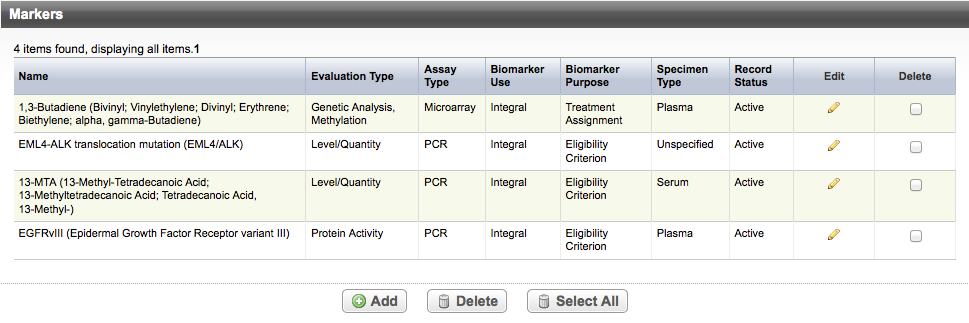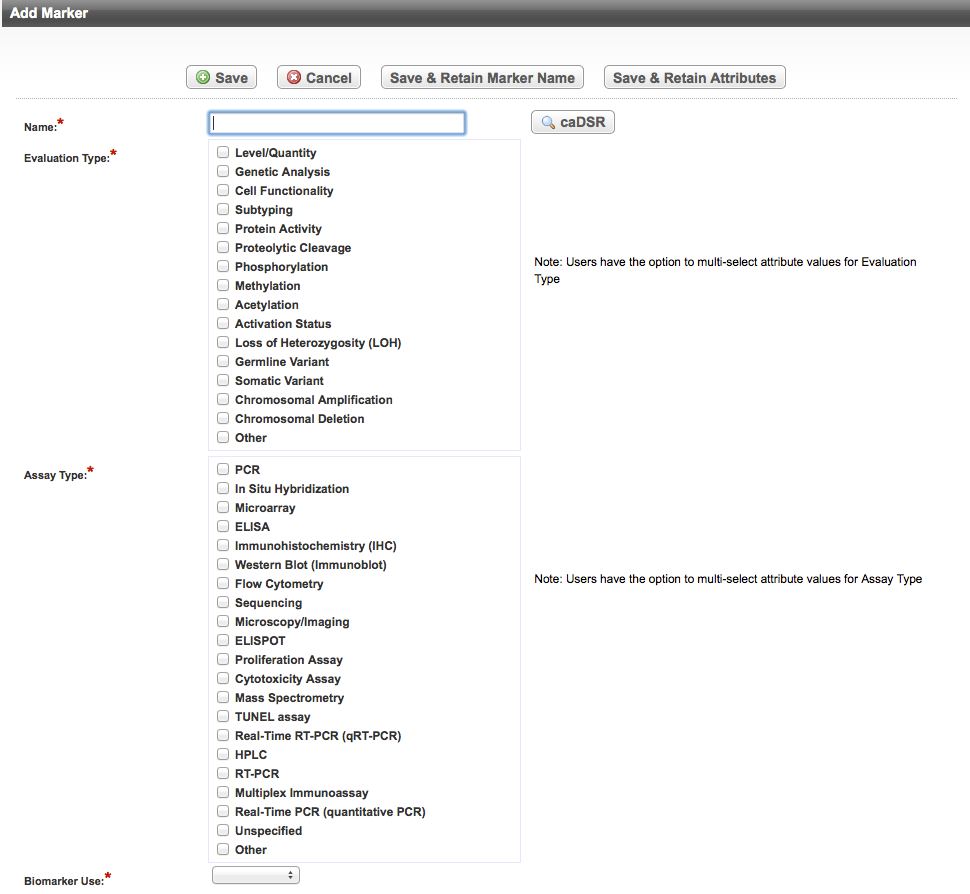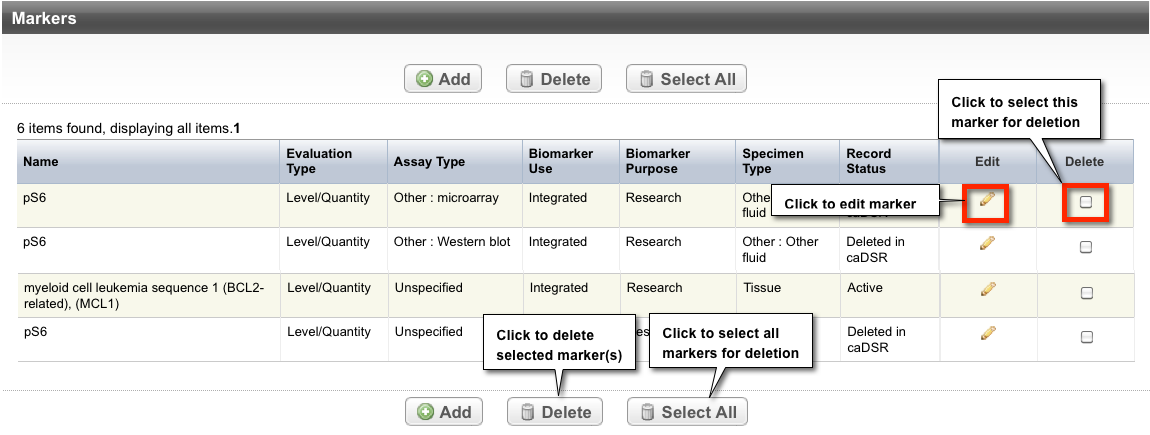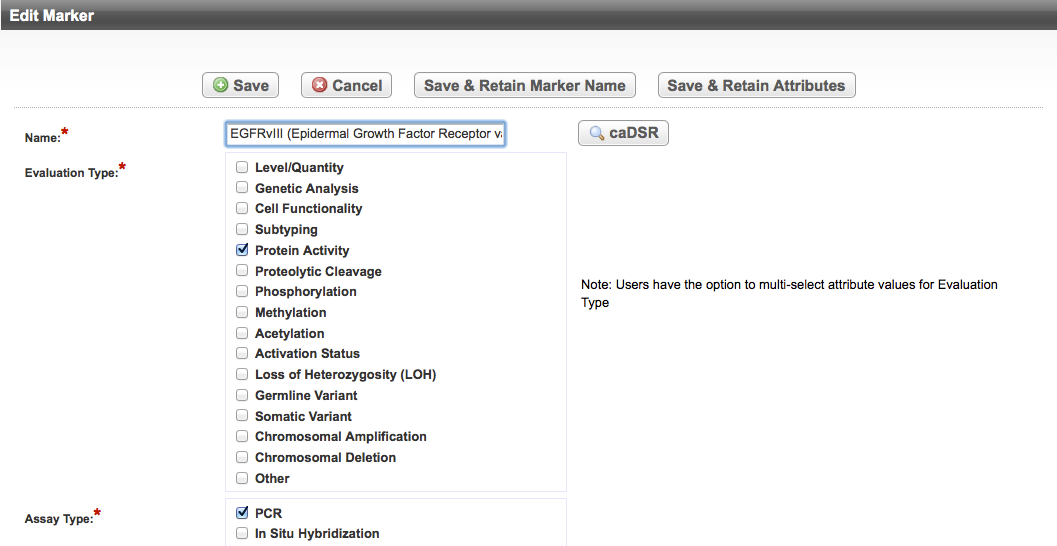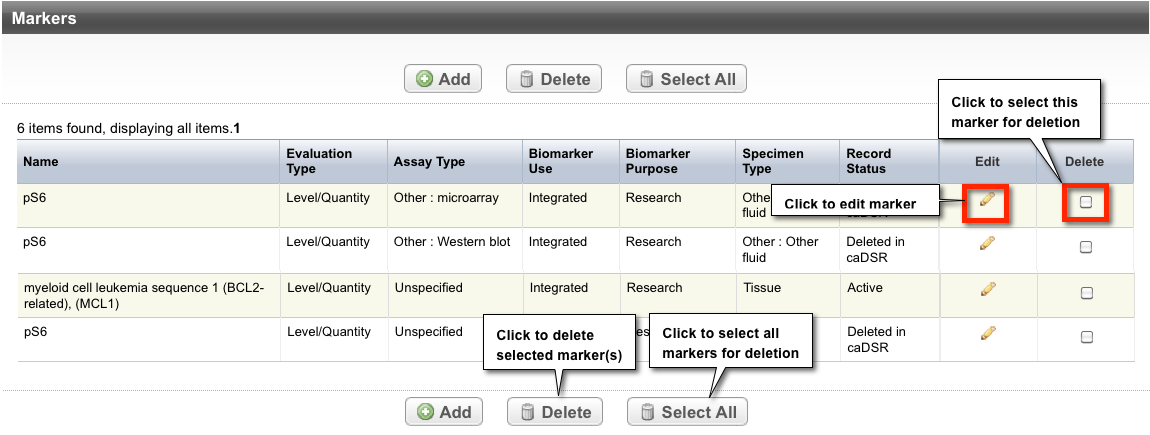The abstraction of biomarkers applies to Complete and Abbreviated trial categories. You can record biomarkers, their classification, and purpose. Biomarkers for a given study may be available from the study protocol documents. You can search caDSR for biomarkers. If you do not find the biomarker in the caDSR, you can create a placeholder entry for the biomarker named in the protocol.
Adding Biomarkers
How to Abstract Markers
Search for the trial of interest. For instructions, refer to Searching for Trials in PA.
In the search results, click the NCI Trial Identifier link for that trial. The Trial Identification page appears.
On the Trial Identification page, check out the trial. For instructions, refer to Checking In and Checking Out Trials. (This checkout step is optional for Super Abstractors.)
On the Scientific Data menu, click Markers. The Markers page appears. It displays any markers that may have been recorded previously.
- Click Add. The Add Marker page appears.
Search for and select the biomarker from the caDSR by following the instructions in Searching for Biomarkers in NCIt.
You can enter a biomarker name directly
If you cannot find the biomarker indicated in the protocol document in caDSR, click Cancel to return to the Markers page, and enter the biomarker name directly in the Name field.
Select the appropriate attributes. The following table describes the fields. An asterisk (*) indicates a required field.
You can select multiple attributes for Evaluation Type, Assay Type, Biomarker Purpose, and Specimen Type.
If you select Other as an attribute for Evaluation Type, Assay Type or Specimen Type, you must enter text in the Evaluation Type Other Text , Assay Type Other Text or Specimen Other Text fields respectively.
Trial Description
Instruction
Name*
Click caDSR and follow the instructions in Searching for Biomarkers in NCIt. If you cannot find the biomarker indicated in the protocol document in caDSR, enter the biomarker name directly in the Name field to create a placeholder value.
Evaluation Type* Select the type of evaluation. Valid values include:
- Level/Quantity
- Genetic Analysis
- Cell Functionality
- Subtyping
- Protein Activity
- Proteolytic Cleavage
- Phosphorylation
- Methylation
- Acetylation
- Activation Status
- Loss of Heterozygosity (LOH)
- Germline Variant
- Somatic Variant
- Chromosomal Amplification
- Chromosomal Deletion
- Other
- Evaluation Type Other Text (displayed and required if Evaluation Type = Other)
Special instructions for "Other" text
If you select "Other," copy and paste the exact name of the evaluation (as written in the protocol) into the Evaluation Type Other Text box.
Assay Type* (CDE ID 64731)
Select the test type(s), the test name(s), or method(s) used to assess a specific marker. Valid values include:
- PCR
- In Situ Hybridization
- Microarray
- ELISA
- Immunohistochemistry (IHC)
- Western Blot (Immunoblot)
- Flow Cytometry
- Sequencing
- Microscopy/Imaging
- ELISPOT
- Proliferation Assay
- Cytotoxicity Assay
- Mass Spectrometry
- TUNEL Assay
- Real-Time RT-PCR (qRT-PCR)
- HPLC
- RT-PCR
- Multiplex Immunoassay
- Real-Time PCR (quantitative PCR)
- Unspecified - Details are not provided, and do not exist in the protocol document
- Other - Other assay type
- Assay Type Other Text (displayed and required if Assay Purpose = Other)
Special instructions for "Other" text
If you select "Other," copy and paste the exact name of the assay/method (as written in the protocol) into the Assay Type Other Text box.
Biomarker Use* (CDE ID 2939411)
Select the value that describes the assay use. Valid values include:
- Integral. Tests that must be performed for the trial to proceed. Includes biomarkers evaluated for the purpose of eligibility/enrollment, stratification, and treatment assignment.
- Integrated. Tests that are hypothesis-driven or measured to support objectives.
Biomarker Purpose* (CDE ID 2939397)
Select the value(s) that describes the reason or intention of the assay in the clinical study. Valid values include:
- Eligibility Criterion. Biomarker measured to help determine if patients can participate in the research trial.
- Treatment Assignment. Biomarker measured to help determine what treatment will be administered (or how much is given).
- Stratification Factor. Biomarker measured to help classify patients into strata as part of the randomization process or for purposes of data analysis.
- Research. Biomarker measured to support a hypothesis or trial objective which cannot be considered response assessment.
- Response Assessment. Biomarker measured to help determine how well the treatment is working or to characterize the impact of treatment.
Specimen Type* (CDE ID 3111302)
Select the type(s) of sample. Valid values include:
- Serum. Clear portion of the blood that remains after the removal of the blood cells and the clotting proteins.
- Plasma. Fluid (noncellular) portion of the circulating blood, as distinguished from the serum that is the fluid portion of the blood obtained by removal of the fibrin clot and blood cells after coagulation.
- Blood (includes Peripheral Blood Monocytic Cells [PBMCs])
- Tissue
- Urine
- PBMCs (Peripheral Blood Monocytic Cells)
- CSF (Cerebrospinal Fluid)
- Bone Marrow
- Saliva
- Cryopreserved Cells
- Buccal Mucosa
- Feces
- Unspecified
- Other
- Specimen Type Other Text (displayed and required if Specimen Type = Other).
Special instructions for "Other" text
If you select "Other," copy and paste the exact name of the specimen (as written in the protocol) into the Assay Type Other Text box.
Record Status
This field is populated by the PA system. When you save the biomarker information, the system sets the marker status to one of the following:
Pending - Indicates that a request for a new permissible value has been submitted 1
- Active - Indicates that the marker was listed in caDSR
- The Pending status changes to Accepted once the Research Scientist enters corresponding Public ID in the Pending Markers Report. For information about updating the status of a marker, see Processing New Marker Requests. ↩
- Do one of the following to save the record:
- Scroll to the top or bottom of the page, and click Save.
- or -
- To create a new record for a different marker but with the same attribute selections, click Save & Retain Attributes. Then search for and select the biomarker from the caDSR, and save the record.
The Marker page displays the record(s) you created.
Searching for Biomarkers in caDSR
The search feature enables you to search for biomarkers listed in caDSR. You can search for biomarkers by the following criteria:
- Search Term. Search for biomarkers meanings that contain the search term
- Search Scope. Search for biomarkers that contain the search term in their preferred permissible values only, in their synonyms (alternate names) only, or in both (the default).
- Public ID. Search for biomarkers by their Public IDs only
If you provide the marker's Public ID, you must enter it exactly, in its entirety.
Additional search options include the following:
- Case-sensitivity. You can elect to make the search term case-sensitive or insensitive. Searches are case-insensitive by default.
- Highlighting search terms. Query text in search results is highlighted by default to make search terms easier to identify. You can turn on or off query text highlighting in the search results.
Most search results list primary terms followed by all possible synonyms in parenthesis in the following order:
- Exact matches for the Primary term
- Matches that contain the search term alone (i.e., the term is not part of a larger term)
- All other matches that contain the search term
The CTRP system synchronizes its data with the caDSR terminology database nightly. In rare instances--for example, if CTRP was unable to connect with caDSR--you will receive a notice that the synchronization failed. The systems synchronize automatically the following night.
How to Search for Markers in caDSR
Search for the trial of interest. For instructions, refer to Searching for Trials in PA.
In the search results, click the NCI Trial Identifier link for that trial. The Trial Identification page appears.
On the Trial Identification page, check out the trial. For instructions, refer to Checking In and Checking Out Trials. (This checkout step is optional for Super Abstractors.)
On the Scientific Data menu, click Markers. The Markers page appears.
- Click Add. The Add Marker page appears.
- Next to the Name field, click caDSR. The Marker Search in caDSR window appears.
Enter all or part of the criteria for the search in the fields provided.
To restrict your search by case, next to Case-Sensitive Search, select Yes (the default is case-insensitive).
To highlight the term you searched for in the list of results, next to Highlight Query Text, select Yes.
Press the ENTER key on your keyboard, or click Search.
The results of your search are listed in a table with their permissible values. 1
In the row that contains the appropriate marker, click Select.
You are returned to the Add Marker page. The Marker Name field is populated with information from the marker you selected.If you do not find the marker you are looking for in the caDSR database, you must create a placeholder. For instructions, see Requesting New Permissible Biomarker Values or Adding Markers from HUGO to the caDSR Database.- The TSR document associated with a trial includes both the permissible value and alternates (synonyms). ↩
Adding Biomarkers from HUGO to the caDSR Database
How to Request Markers from HUGO for Addition to the caDSR Database
Search for the trial of interest. For instructions, refer to Searching for Trials in PA.
In the search results, click the NCI Trial Identifier link for that trial. The Trial Identification page appears.
On the Trial Identification page, check out the trial. For instructions, refer to Checking In and Checking Out Trials. (This checkout step is optional for Super Abstractors.)
On the Scientific Data menu, click Markers. The Markers page appears.
- Click Add. The Add Marker page appears.
- Next to the Name field, click caDSR. The Marker Search in caDSR window appears.
- Click Create Biomarker Request.
The Create Permissible Value Request window appears, with your email address in the Sender's Email address field.
- Select the Found in HUGO? check box, and then click the HUGO link.
The window displays a new field for the HUGO marker code, and the HGNC database is launched in a new browser window. - Search for the marker in the HGNC database, and then enter the HGNC ID number for the appropriate record into the Hugo Marker Code field. This field is displayed only when you select the Found in HUGO? check box.
- In the Text of marker as written in the protocol field, copy and paste, or enter, the information about the marker as it appears in the protocol.
- Click Send Email.
Your request is sent to the caDSR for processing. The value you requested is listed on the Pending Markers Report with the Pending status. You can return to the Pending Markers report later to enter the Public ID number once caDSR has sent notification to the Research Scientist that the new term was created. (See Processing New Biomarker Requests.)
Editing Biomarkers
How to Edit Marker Records
Search for the trial of interest. For instructions, refer to Searching for Trials in PA.
In the search results, click the NCI Trial Identifier link for that trial. The Trial Identification page appears.
On the Trial Identification page, check out the trial. For instructions, refer to Checking In and Checking Out Trials. (This checkout step is optional for Super Abstractors.)
On the Scientific Data menu, click Markers. The Markers page appears.
- To edit a marker, in the Edit column, click the Edit (pencil) icon.
The Edit Marker page appears.
- Follow the instructions for selecting and saving attributes in Adding Biomarkers to change the recorded information.
Deleting Biomarkers
How to Delete Marker Records
Search for the trial of interest. For instructions, refer to Searching for Trials in PA.
In the search results, click the NCI Trial Identifier link for that trial. The Trial Identification page appears.
On the Trial Identification page, check out the trial. For instructions, refer to Checking In and Checking Out Trials. (This checkout step is optional for Super Abstractors.)
On the Scientific Data menu, click Markers. The Markers page appears.
- Do one of the following to select the markers you want to delete:
- To delete a marker(s), select the check box in the Delete column for the appropriate marker record(s). You can select multiple records.
- or - - To delete all markers, click Select All.
The button changes to Deselect All.
- To delete a marker(s), select the check box in the Delete column for the appropriate marker record(s). You can select multiple records.
- Optionally, to clear all check boxes, click Deselect All.
- Click Delete, and then confirm that you want to delete the record.
Warning
There is no way to recover a deleted record. If you delete a record accidentally, follow the instructions in Adding Biomarkers to add it back.
Requesting New Permissible Values for Biomarkers
How to Request New Permissible Values for Biomarkers
Search for the trial of interest. For instructions, refer to Searching for Trials in PA.
In the search results, click the NCI Trial Identifier link for that trial. The Trial Identification page appears.
On the Trial Identification page, check out the trial. For instructions, refer to Checking In and Checking Out Trials. (This checkout step is optional for Super Abstractors.)
On the Scientific Data menu, click Markers. The Markers page appears.
- Click Add. The Add Marker page appears.
- Next to the Name field, click caDSR. The Marker Search in caDSR window appears.
Click Create Biomarker Request.
The Create Permissible Value Request window appears, with your email address in the Sender's Email address field.
- In the Marker Name field, enter the most appropriate biomarker name followed by the name as it appears in the protocol in parenthesis if the two are not identical.
- In the Text of marker as written in the protocol field, copy and paste, or type, the information about the marker as it appears in the protocol.
Click Send Email.
Your request is sent to the caDSR for processing. The value you requested is listed on the Pending Markers Report with the Pending status. You can return to the trial later to accept it once it has been processed. (See Processing New Biomarker Requests.)

